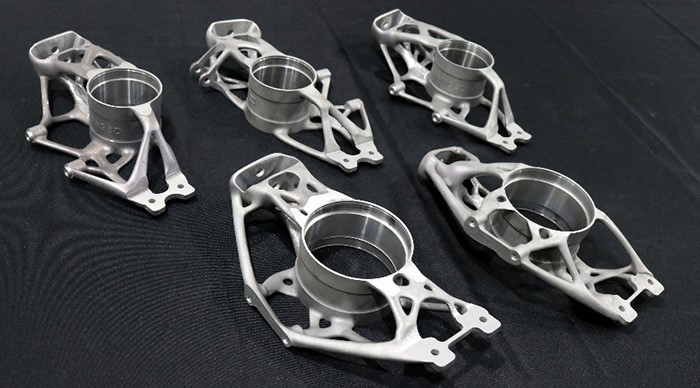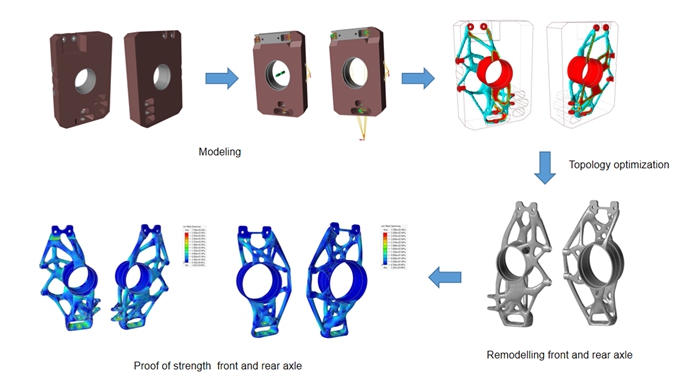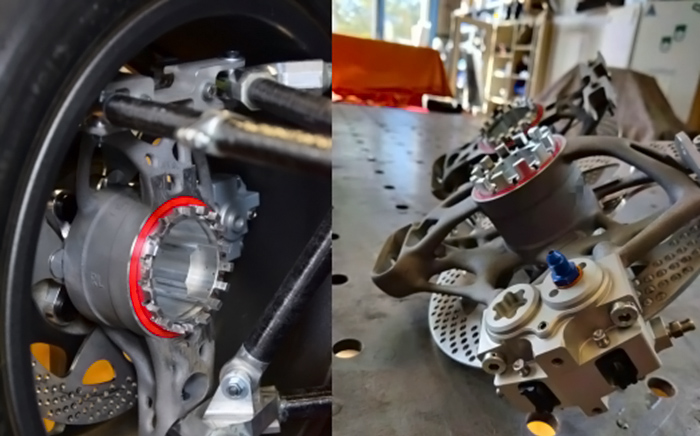The 2021 3D Printing Industry Awards shortlists are now open for voting until the 20th of October. Cast your votes here.
The Delta Racing Team of the Mannheim University of Applied Sciences partnered with Hangzhou-based 3D printer manufacturer Eplus 3D to produce end-use parts for this year’s Formula Student Electric event.
Formula Student is an engineering design contest that sees university students build their own race cars. The teams are then pitted against each other in an annual racing event with a Formula 1 style track.
Using an EPlus 3D EP-M250Pro metal 3D printer, the Delta Racing Team integrated a set of topologically optimized aluminum wheel carriers into its racing car for the first time. The 3D printed parts reportedly resulted in weight savings of over 50% when compared to the original CNC-milled components – a huge performance advantage in the world of motorsports.

The importance of weight
It’s no secret that on the track, weight plays a major role in how a vehicle performs. For as long as motorsports have existed, racing teams have strived to lightweight every component in their cars, squeezing every millisecond they can out of a design. This includes the wheel carrier, which is tasked with supporting a car’s wheel bearing, and therefore also the wheel itself. It serves to absorb and transmit forces between the tarmac and the rest of the car’s chassis.
For this year’s race series, the Delta Racing Team used a computer-aided design technique called topology optimization to optimize its wheel carrier components. The approach works by computationally simulating the loads experienced by a part and generating a geometry better-suited to tackling them, all while shaving off any unnecessary material to maximize part performance.
In total, Mannheim’s racing team ran a total of 18 load cases to inform the design, including maximum vertical impact, braking in a pothole, braking in reverse, and an extreme cornering case.

3D printing the optimized wheel carriers
Before the wheel carriers could be printed in aluminum, they were first prototyped in low-cost PLA on an FDM 3D printer. This proved the manufacturability of the design, and the final parts were fabricated on an industrial-grade EP-M250Pro powder bed fusion system.
To get the build off the build plate, the team annealed the platform in a vacuum furnace to lower the stresses inside the parts. Then, with the help of a wire eroding machine, the components were lifted off the plate and the support structures were removed. The final stages of post-processing involved sandblasting the 3D printed parts to improve the surface quality and machining some of the edges on a 5-axis CNC to perfect the dimensional precision.
When all was said and done, the 3D printed wheel carriers weighed in at 550g apiece – a 50% reduction on the previous year’s conventionally manufactured counterparts. With the new design, all forces around the wheel belonged to unsprung masses, meaning they acted directly on the vehicle without being delayed by springs and dampers. The significant reduction in unsprung masses resulted in a noticeable boost in agility and handling.

The automotive and motorsport sectors have been prime adopters of 3D printing over the past few years. Earlier this year, NASCAR team Stewart-Haas Racing turned to 3D printing to produce end-use brake pedals 32% lighter than their conventional counterparts. Working with Autodesk, the team managed to use Fusion 360 generative design software to improve the rigidity and overall safety of the components too.
Elsewhere, the Kawasaki Puccetti Racing team recently integrated 3D scanning and 3D printing into its day-to-day workflows, revealing that it used additive manufacturing to win Round 5 of the World Superbike Championship in Italy in 2019. Specifically, the team used a RangeVision 3D scanner to scan its Kawasaki racing motorcycle and optimized the fairing of the 3D model using aerodynamic modeling algorithms.
Subscribe to the 3D Printing Industry newsletter for the latest news in additive manufacturing. You can also stay connected by following us on Twitter, liking us on Facebook, and tuning into the 3D Printing Industry YouTube Channel.
Looking for a career in additive manufacturing? Visit 3D Printing Jobs for a selection of roles in the industry.
Featured image shows the final 3D printed wheel carriers. Photo via Eplus 3D.
